






Decarbonising university estates is now more achievable than ever with Mitsubishi Electric’s renewable heat pump and chiller technology. We’ve partnered with universities like Durham and Salford to implement low-carbon HVAC solutions that utilise lower-GWP refrigerants and reduce embodied carbon. Our offerings include commercial heating systems for hot water and space heating and modular high performance chillers for scalable heating and cooling. Backed by our robust MELServe aftersales service, our solutions ensure continuous optimal performance and longevity.
Discover our full product range at: les.mitsubishielectric.co.uk


Editor Chris Hewett editorial@mebmedia.co.uk
Accounts Jay Kempisty accounts@mebmedia.co.uk
Publisher Wayne Banks +44 (0)1622 201207 wayne.banks@mebmedia.co.uk
Website and Circulation Manager Kevin Villa website@mebmedia.co.uk
Design and Production Charles David production@mebmedia.co.uk
Campus Estate Management
Magazine is published 4 times a year by MEB Media Publishing Ltd 13 Princes Street Maidstone Kent ME14 1UR United Kingdom Tel: +44 (0)1622 201207, info@mebmedia.co.uk www.mebmedia.co.uk
Articles and art may not be reproduced or reprinted without the express written permission of the publisher.
Exclusion of Liability
Although every effort will be made to ensure the accuracy of all materials published, the publisher takes no responsibility for errors or omissions.
Copyright © MEB Media Publishing Ltd 2024, all rights reserved.




4 Digital strength for our students
Can a keyless world unlock better campus security?
8 Product & Industry News
The latest news and views on campus
22 Transforming sustainability in HE UWTSD aims high with renewable energy
26 Top of the world
Delivering durable and sustainable roofing
30 Sparkle and shine
The most futuristic window cleaning tech available now
34 Legionella risk in schools
Key points for good water management
38 A Sporting Start
Students officially open new sports hall at Minsthorpe Community College
42 Eco-efficient flooring footprint
Collaboration and sustainability focus for Altro

Bruce Donald, UK & Ireland Manager for SimonsVoss, discusses the evolving needs of campus access and security.
As educational environments become increasingly complex, securing campus facilities and ensuring student safety is now a top priority for building and facility managers in schools, colleges, and universities worldwide.
These institutions face a range of security challenges, and digital locking systems are emerging as a powerful solution, offering enhanced control, real-time monitoring, and seamless integration with emergency protocols.
Meeting today’s security needs in education
Traditional campus environments were often characterised by open
spaces, free access, and minimal barriers.
However, that is no longer a reality for education building and facility managers. Recent years have seen a shift, driven by a combination of factors, ranging from higher enrollment numbers and diverse building layouts to evolving security threats.
Educational facilities have become larger and more complex
too, often serving as multifunctional spaces that host not only academic activities but also extracurricular and community events.
This complexity introduces challenges in controlling who enters and exits various parts of the campus.
The Complete University Guide estimates that a third of UK university students become a victim of crime – mainly theft and burglary – and roughly 20% of student robberies occur in the first six weeks of the academic year.
This, coupled with the fact the UK has seen a rise in the number of first-year students choosing purposebuilt accommodation, rather than house-share arrangements, mean there is a pressing need for advanced security measures that protect both the students residing in these multioccupancy accommodation buildings, as well as the property itself.
What Are Digital Locking Systems?
Digital locking systems are sophisticated, wireless access control solutions that allow administrators to manage access across different areas of a campus with ease. Unlike traditional keys, digital locks are programmed to provide access based on credentials like key cards, transponders, or mobile phones, granting or restricting entry as needed.
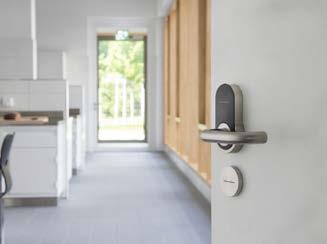
These systems also offer invaluable insights through real-time monitoring and reporting. Campus security teams can see who accessed specific areas and when, allowing swift action in response to suspicious activity. For universities, this capability makes it possible to respond quickly to security threats and better manage access during events, for contractors, and for visitors - all without compromising the safety of students and staff.
Russell Waller, Head of Buildings and Services at Cambridge University’s Trinity Hall has seen the benefits of electronic key
management systems within his own buildings. He said, “Keyless access solutions have dramatically reduced the time previously spent travelling to a central point to collect the correct keys. Additionally, it means that multiple personnel can independently access the same building and that lost keys are no longer a legacy security issue.”
Enhancing health and safety with digital locking systems
Health and safety are critical priorities for any educational facility, and digital locking systems are increasingly central to these
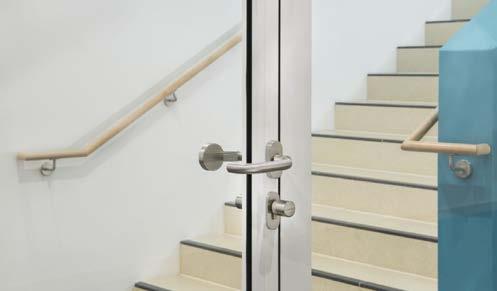
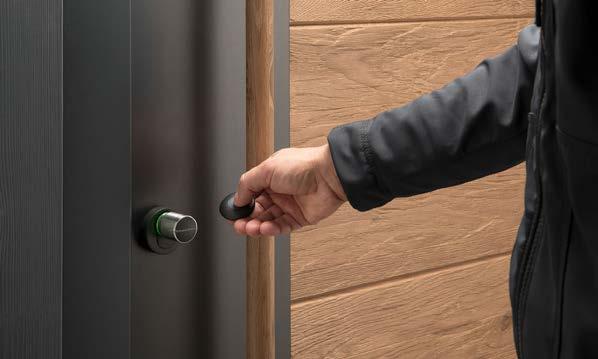
strategies.
Educational institutions need robust, compliant solutions that help them meet UK fire safety regulations, especially regarding door hardware. Digital locking systems, when paired with certified third-party door hardware, can support schools and universities in achieving compliance.
According to UK standards, door hardware used on fire doors should be CE marked; however, this alone does not guarantee suitability for fire door applications. To meet safety requirements, door closers on fire doors should be chosen with consideration for user accessibility and adherence to regulatory standards.
Schools and universities must accommodate individuals of all ages and physical abilities, making it essential that fire door closers meet the required standards to ensure safe exits during emergencies. Digital locking systems allow controlled access while securing exit routes, enabling safe building evacuation without compromising security. This dual functionality ensures that buildings remain protected from unauthorised access while providing secure, compliant escape routes in the event of an emergency.
Digital locks also help secure
high-risk areas, such as laboratories or maintenance rooms, that require restricted access due to hazardous materials or specialised equipment.
Bruce Donald, UK and Ireland Manager for SimonsVoss, said, “In universities with extensive research facilities or vocational training, the ability to control who enters these zones is crucial for accident prevention. Digital access logs also provide accountability, allowing administrators to track who accessed specific areas and when, supporting compliance with safety standards and helping reduce health risks.”
Addressing mental health and student well-being through security
An often-overlooked aspect of campus security is its role in supporting mental health. For many students, especially those facing anxiety or adjusting to new environments, feeling secure on campus can have a significant impact on their well-being.
Knowing that access to accommodations or study areas is monitored and controlled can bring peace of mind to students and contribute to a more positive, supportive atmosphere on campus.
For students in shared housing or campus accommodations, digital
locking systems offer additional privacy and security, particularly in high-stress times, such as exam periods. Students can focus on their studies and feel safe in their personal spaces, fostering a healthier campus environment.
Conclusion: A Long-Term Investment in Campus Safety
As educational institutions face growing demands for security and safety, digital locking systems provide a scalable, proactive solution to meet these needs. With capabilities that extend beyond basic security to include comprehensive emergency response, real-time monitoring, and controlled access to sensitive areas, digital locks help build a safer campus environment.
For educational institutions, investing in digital security infrastructure is an investment in both student safety and institutional resilience. By adopting digital locking systems, schools, colleges, and universities can focus on creating an environment where students not only feel safe but are empowered to thrive academically, socially, and personally.
For further information please visit www.simons-voss.com/en.

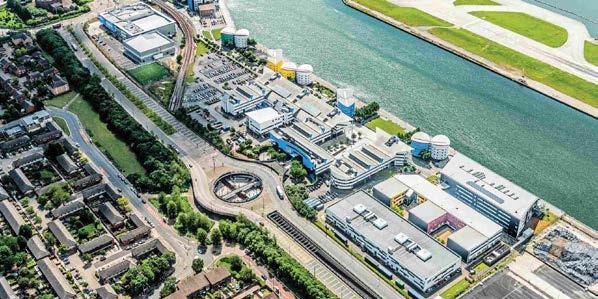
The new WSHP is set to be the largest fitted at any university and will power the university’s Docklands Campus Library and Royal Docks Centre for Sustainability buildings, replacing existing gas boilers – and together with campus existing green energy infrastructure, achieve carbon zero in these spaces.
Submerged in the River Thames, the closed-loop system will use a series of pipes to extract natural heat from the water in the Royal Albert Docks, providing a cost-effective heating system which will reduce annual CO2 emissions by 258 tonnes without removing vast quantities of water from the river.
The system is scalable to allow the university to extend in the future similar heat pump systems across the Campus and the wider Royal Docks – the only Enterprise Zone in London – and is part of the long-term partnership with Siemens, which is supporting the university’s transition to net zero by 2030.
The strategic partnership, which was formed in 2022, has already seen Siemens deploy a variety of decarbonisation technologies including solar PV, Building Management Systems and EV charging infrastructure across the university campus. In addition, Siemens is using its Building X technologies and data analytics to allow UEL to better understand its energy consumption and drive research and enterprise programmes.
UEL has reduced its CO₂ emissions and carbonproducing energy consumption more than any other modern London university already, and by 2026 will achieve the lowest emissions per student in the UK –putting it on track to achieve its 2030 net zero targets.
The partnership is providing a clear, replicable blueprint for sustainability. As well as saving the university over £500,000 per year in utility costs and reducing emissions by over 1,000 tonnes annually, the partnership has driven a unique range of successful
green employability, enterprise and research initiatives including student internships, MSc sponsorships, hackathons, and the creation of a ‘Living Lab’ for training and research on sustainability.
This project directly supports the Mayor of London’s vision for a greener, more sustainable capital, advancing his commitment to cleaner air, renewable energy, and achieving net zero by 2030.
Mayor of London, Sadiq Khan, said: "London is leading the way in the fight against climate change, and projects like this pioneering partnership between the University of East London and Siemens are key to our city’s transition to a greener, more sustainable future. By harnessing the power of the River Thames to heat university buildings, this initiative demonstrates how innovation and collaboration can drive real progress towards net zero. It not only reduces carbon emissions but also sets a powerful example of how London’s institutions can embrace cutting-edge, clean energy solutions to build a better, fairer and greener city for all Londoners."
Andrew Smyth, Head of Sustainability for Smart Infrastructure Buildings, Siemens UK and Ireland, said: “Decarbonising heating systems is a critical step towards achieving net zero carbon emissions. The University of East London has a fantastic resource in the Thames, right on its doorstep. Harnessing renewable power from the water allows it to take huge steps towards its net zero goals.
Building X is Siemens' digital building platform designed to digitalise, manage, and optimise building operations. It aims to enhance user experience, increase performance, and improve sustainability. Building X integrates various applications and services, including energy management, security management, and building automation, to create a unified data environment that enhances accuracy and efficiency.

Introducing the Accorto by Electrorad, not only an exceptonally intelligent aluminium radiator, its heatng control is designed for student accommodaton, hotels and propertes where landlords or property managers may want to set limits on energy usage.
The ability to manage costs and avoid excessive heatng caused by over zealous users is a game changer.
The Accorto has 3 clever functons which will help control the radiators.
• Constant set back - this great feature enables the radiators to be set, locked and more importantly unlocked by the app alone. The property manager can also opt to put the radiator into a constant setback and lock it, this then allows the “one buton boost” functon to be actve which gives a boost of 23°C for 45 mins and then returns to setback.
• Occupancy sensing and temperature reductons – the Accorto uses microwave sensing to detect presence in a room, but rather than switch of immediately it reduces the temperature over a period of tme ensuring that any low levels of actvity are not mistaken for an empty room as ofen happens with PIR
• Landlord Lock functon - once you've picked your preferred operatonal mode you can lock those setngs in and rest assured that they cannot be unlocked without the app access.
The Accorto will revolutonise electric heatng and its ability to be managed within student accommodaton, hotels and all managed propertes. The Accorto is available through all electrical wholesalers.
For further informaton visit www.electrorad.co.uk.
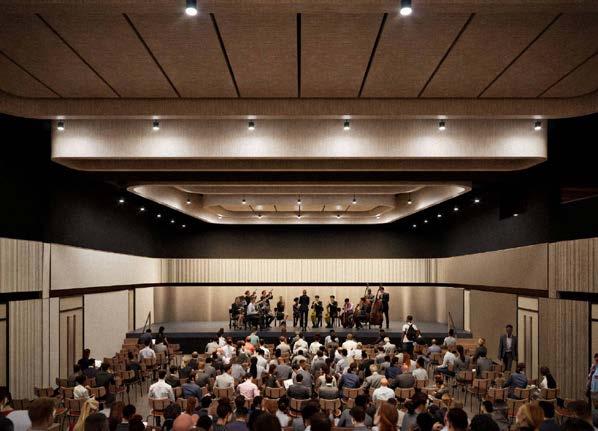
Global delivery consultants and construction experts, Mace have been appointed to redevelop Imperial College London’s largest venue, The Great Hall, located in the Sherfield Building on its South Kensington campus.
Mace’s retrofit team will transform the 4,230 sq. ft. hall into a flexible, multipurpose space, that can be converted into three lecture theatres.
Designed by Burwell Architects, a key feature will be the creation of removable partitions, enabling the hall to be divided into three distinct areas while retaining its function as an event space. These motorised partitions will provide high acoustic insulation between sections, supported by a state-of-the-art AV system to allow seamless transitions between different configurations.
In addition, semi-automatic retractable seating will facilitate a quick switch from a theatre setup to an open-space configuration when the hall is used as a single large venue.
The work will be carried out within a live environment, with the Sherfield Building remaining fully operational throughout construction.
Stewart Ward, Managing Director Fit Out & Retrofit, Mace Construct:
“Transforming Imperial’s Great Hall into a multipurpose space with removable motorised partitions is an ambitious forward-looking project, which will set a new standard for quality for future buildings on the campus.
“This space has always been used for a wide range of memorable events and its redevelopment will mean it can easily be converted into a theatre style set up as well as three new separate teaching spaces to benefit the campus community.”
Adam Srodzinski, Director of Capital Projects and Estates Management, Imperial College London:
“The redevelopment of the Great Hall is an exciting step forward for Imperial, transforming this historic space into a truly flexible venue for both world-class teaching and major events. This project is a milestone in our ambition to create campuses that inspire current and future generations.”
Completion is expected in summer 2026. The Great Hall is Mace’s second project for Imperial College London, following the successful completion of the National Heart and Lung Institute, a cutting-edge lab and workplace advancing research in respiratory science.



MARKING a key development milestone, work has begun to construct a brand-new secondary school for pupils with special educational needs (SEN) in Greenwich.
Located on Hargood Road, Rowan Wood School will provide 128 places for children aged 11-19 with autism (ASD) and complex needs, and is set to complete later this year.
The two-storey SEN facility will be situated on the site of former primary school Kidbrooke Park, which has been demolished to make way for the new purpose-built school.
Designed to Department for Education (DfE) regulations and Building Bulletin 104 (BB104) guidelines, Rowan Wood will consist of three modular buildings which will be linked together, with one building dedicated to administration and dining, and the other two designed for teaching.
Multi-disciplinary consultancy Pick Everard is behind the project, providing project management, cost management, and health and safety services via the Crown Commercial Service Construction Professional Services framework, working in close collaboration with contractor Galliford Try and architects Haverstock.
Simon Hembury, associate director of project management at Pick Everard, said: “It’s always rewarding to work on SEN schools and consider the unique design requirements that staff and pupils will need from their space.
“At Rowan Wood, that means we’re consulting extensively with various stakeholders to ensure we are designing an inclusive space for all, in line with DfE regulations.
“The site is located in a residential area, so we have worked very closely with both the Royal Borough of Greenwich and Galliford Try to ensure minimal
disruption and ensure everyone is on board with a project that will really transform local educational need in the area.
“We’re looking forward to seeing the site evolve over the course of the year and have a positive impact on the region.”
As part of the project, the team cleared a large amount of asbestos from the previous school building onsite, ensuring the area is safe for future construction.
Helping maintain quality and efficient standards of delivery, offsite construction methods will be used to construct the new school, with transport routes carefully determined to deliver goods and materials to the site.
PV panels will also be installed on the roof, with the project targeting BREEAM Excellent.
Gavin Bridge, managing director for building southern at Galliford Try, said: “This event marked the start of our collective journey towards providing an exceptional SEN school. We are excited to work alongside the Royal Borough of Greenwich and our partners to bring Rowan Wood school to life. Providing every child with the opportunity to thrive, to learn, and to grow in a setting designed to meet their unique needs and aspirations.”
Cllr Majid Rahman, cabinet member for planning, estate renewal and development, said: “This day marks the start of an exciting new chapter for our local education and planning sectors. This is tangible proof of the resource we are inputting into much needed positive developments for our residents. We are working on building more provisions like this in the borough to meet demand which I am eager to see come to fruition.”
For more information on Pick Everard’s services, head to www.pickeverard.co.uk

Luna Students, a leading provider of purpose-built student accommodation (PBSA) management services and part of Torsion Group, is pleased to announce its new leadership team. The appointments mark a significant step in Luna’s ambitious growth strategy, positioning the company to enhance student living experiences while driving value for property owners. We’re especially proud that our leadership team is majority female —an important distinction in a sector where this remains rare.
Louise Bena, Managing Director
With over 15 years of experience in the PBSA sector, Louise is a strategic leader with a proven track record in driving occupancy, enhancing student experiences, and maximising asset value. Having held senior roles at Unite, Liberty Living, GSA/Yugo, and StudentCrowd, she brings a wealth of expertise in sales, marketing, and strategy. Louise’s vision for Luna Students is centred around operational excellence and industry-leading student experiences.
Stuart Henderson, Operations Director
Stuart has been at the forefront of PBSA operations for over a decade. Beginning his journey as General Manager at The Student Housing Company in 2014, he quickly ascended to European Head of Operations at Yugo, overseeing 20,000 beds. His leadership has garnered multiple industry awards, including International Operator of the Year at the 2020 Student Accommodation Awards. Stuart’s expertise in operational efficiency, team leadership, and ESG strategies will be instrumental in Luna’s continued growth.
Rosie Hill, Marketing Director
Rosie began her decade-long career in PBSA as a Resident Assistant at The Student Housing Company, quickly advancing to Digital Marketing Specialist. She
later played a key role in the rapid expansion of PBSA portfolios, successfully launching new markets across nine countries as Head of Marketing at Nido Living and contributing to 12 industry award wins during her tenure.
With expertise in brand development, demand generation, and strategic market entry, and named one of EG’s Rising Stars of Real Estate in 2023, her appointment will support LUNA’s ambitious growth, expanding its presence in new locations and strengthening student engagement.
Shelley Bellett, Commercial & Operations Director Shelley brings over 17 years of experience in PBSA, having held key roles at Yugo, Liberty Living, The Student Housing Company and Project Student. She specialises in building high-performing teams and optimising commercial and operational functions. She has a keen ability to enhance student experience while delivering strong financial performance. Shelley’s leadership will ensure Luna’s growth remains peoplefocused, aligning with its commitment to providing exceptional student living environments.
Luna Students work closely with Torsion Developments to achieve the highest 3-Star Fitwel Certification in the UK, and excellent BREEAM ratings reinforcing its commitment to creating healthy and sustainable student living environments.
LUNA Students currently has over 700 beds live for 2025 and a pipeline of over 2500 beds as part of their rapid growth plan to own and operate over 4,000 beds in the next 4 years. As a third-party operator, Luna is expanding its reach through strategic partnerships, leveraging its expertise to provide best-in-class student accommodation management services.
For more information on Luna Students, please visit www.lunastudents.co.uk.
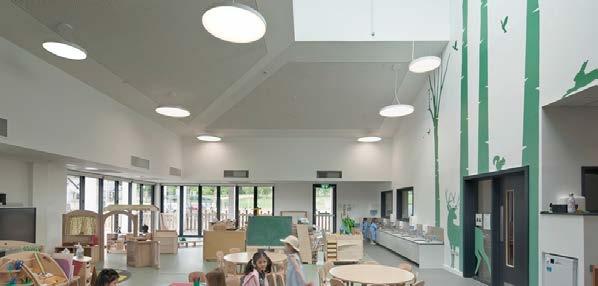
Discover how Zumtobel and its sister brand Thorn, both lighting brands of the Zumtobel Group, helped the new Milltimber School become an award-winning educational facility, promoting sustainability, wellbeing, and a conducive learning environment.
The £16.4 million Milltimber School, part of the Oldfold Farm development, earned the Aberdeen Society of Architects (ASA) Education Design Award 2023. As part of a £100 million investment by Aberdeen City Council in four new schools, the facility offers modern, sustainable, and inclusive learning spaces for the growing catchment area.
To meet the evolving educational needs of the community, the ambitious project aimed to create spaces that encourage active learning and enhance student experiences.
A key success of the design was how the spaces between the buildings were utilised to create moments that could enhance curriculum delivery. The shape and structure of the rooms, alongside colourful wayfinding and nature-themed supergraphics, reflect the natural forms of nearby landscapes and help define the character within the school's spaces.
A lighting manufacturer to meet expectations
Discover how Zumtobel and its sister brand Thorn, both lighting brands of the Zumtobel Group, helped the new Milltimber School become an award-winning educational facility, promoting sustainability, wellbeing, and a conducive learning environment.
Wallace Whittle M&E practice, describes, "The lighting design was a dynamic process due to changing spaces, but Zumtobel's adaptability, wide range of luminaires and history of successful projects made them the perfect partner for this project."
Today, the school boasts a sophisticated lighting solution that enhances the learning environment and meets sustainability goals.
A combination of Zumtobel and Thorn luminaires have provided the biggest visual impact, creating a natural and comfortable learning environment within the classrooms. From the nursery, corridors, and bathrooms, to the classroom, back of house areas and sports hall, the lighting design includes Zumtobel's SLOTLIGHT infinity, ALVA, ONDARIA, CRAFT II plus, RESCLITE PRO, and PANOS Q, alongside Thorn Lighting's IQ Wave, Chalice, Beta2, Aquaforce, Piazza, Katona, and Omega Pro 2.
The services and lighting have all been positioned to allow easy installation of class division partitions should an alternative layout be required, allowing the school to adapt the spaces for future use.
The lighting installation has resulted in significant benefits, including low energy use, low maintenance costs, and a positive impact on the overall learning experience for both students and staff.
Zumtobel and Thorn's lighting solutions were crucial in making the Milltimber School a success. Their commitment to sustainability, innovation, and creating spaces that enhance education, aligns with the school’s vision, resulting in a broader trend of smart, energyefficient lighting in educational facilities.
For more information visit www.thornlighting.co.uk or https://z.lighting/en/zumtobel/.






TWO NEW BUILDINGS

















126,000 SQ FT FLEXIBLE FLOORPLATES EDUCATION USE CLASS F1 AVAILABLE NOW




LONDON E15

Scott Brownrigg, an international design practice, has secured planning permission for the T-Levels Building, a new University Technical College (UTC) facility adjacent to the University of East London Docklands Campus, that expands the existing London Design & Engineering (LDE) UTC’s teaching facilities. The new scheme will provide additional workshops and teaching spaces, allowing the college to increase the learning environment for its students.
The new, three-storey building will overlook the Royal Albert Dock to the south. The building’s entrance will be located across a compact central square from the existing LDE building, creating a connection between the two buildings and a focal point for the developing industrial and research facilities in the area. Like the existing LDE building, the new T-Levels Building will feature dark grey terracotta cladding on the ground floor and dark-grey vertical profiled metal cladding on the upper floors. Bright yellow accents – around the entrance and on some windows - will provide visual continuity with bright yellow columns that form an exuberant colonnade along LDE college’s southern elevation.
The new facility will include cutting-edge technical equipment and industry-standard spaces, co-designed with employer partners to meet the demands of the modern workforce. Providing these additional spaces for students will also open up spaces within the existing college for enhanced community programming and public events.
The landscape design will extend the existing material palette and treatment across the new site, enhancing consistency and cohesion. This includes
paving material and pattern choices, to match the walkways around the existing UTC.
The building’s design takes on the ‘Fabric First’ approach with a well performing envelope that aligns with both the Department for Education and the local authority’s sustainability criteria. The design also caters for future expansion and flexibility, allowing the building to be easily adapted in response to the UTC’s future needs.
Construction on the new T-Levels building is anticipated to complete in late summer of 2025. UTCs o er T- Levels, full-time, technically oriented education to 14 – 19-year-olds, in preparation for higher education or employment.
Oliver Thomas, Project Director at Scott Brownrigg, said: “Continuing to develop LDE UTC’s estate acknowledges the success of the first building that we delivered for them in 2018. Being able to design buildings that facilitate the aspirations and development of individuals and communities, whilst supporting the sustainable growth of both the borough and LDE UTC, is something that we are very proud of.”
Geo rey Fowler, CEO and Founding Principal of LDE UTC, said: “This project is about much more than a building. It’s about investing in young people, addressing the UK’s skills gap, and providing the tools for learners to realise their potential. We are grateful for the overwhelming support from stakeholders, the Greater London Authority (GLA), the Royal Docks Team, Newham Council, our local community and our sponsors Costain, Skanska, Thames Water, the Diocese of Chelmsford and UEL. Together, we are shaping a brighter future for Newham’s young people”.

Forbo Flooring Systems has renewed its Eternal collection of general purpose vinyl, with a focus on expertise in design, performance and sustainability –with increased recycled content, lower embodied carbon and an adhesive free range now available. Offering new contemporary wood and stone patterns and a mattesatin finish for a more natural and realistic appearance, Eternal allows architects and specifiers to create beautiful flooring schemes across a range of spaces.
Forbo’s Eternal vinyl flooring has been a trusted solution on the market for over 20 years, known for its outstanding quality and thoughtful design. Further demonstrating the manufacturer’s expertise, Forbo has added a range of innovative colourways to the main Eternal collection. The refreshed palette and new mattesatin embossing both offer a more realistic, premium aesthetic, with the wood effects expertly crafted to rival the beauty of their natural counterparts.
Suitable for cold-weld installations for a more seamless look, Forbo’s refreshed Eternal offering is ideal for specifiers looking for a cost-effective, ‘nohassle’ and functional flooring solution, in place of real wood or stone flooring.
The balanced construction of Eternal delivers market-leading residual indentation, while Forbo’s PUR Pearl lacquering and embossing techniques ensures exceptional protection against scuffs and scratches.
Speaking on the updates, Donna Hannaway, Head of Marketing UK and Ireland from Forbo Flooring Systems, said: “Our Eternal vinyl collection has been a go-to, trusted solution for over 20 years. This new collection represents a step forward. Credit to its superior quality, cutting-edge designs and enhanced sustainability, Eternal continues to set new standards in flooring
solutions.
“With a refreshed colour palette, including new designs like infinite oak, the geometric Prism and Woodmix (a terrazzo visual), specifiers now have a wealth of options to choose from.
Adding a timeless appeal to any interior, ensuring your space remains stylish and contemporary for years to come, our refreshed Eternal collection can transform any space with unmatched beauty and durability.”
Forbo continues to invest in enhancing the sustainability of its collections, with the main Eternal range now featuring 30.5% recycled content and manufactured in factories using 100% renewable electricity – the embodied carbon of this collection has also been significantly reduced.
The Eternal collection also now benefits from a 50% increase in its product guarantee when installed with Forbo’s Coral and Nuway entrance flooring systems, meaning fewer replacements over the building’s lifecycle.
The updates also include an adhesive-free range, Eternal Next, which will join the Fast Supply Fast Fit family alongside Modul’up 19 dB and Surestep Fast Fit. Locally stocked for fast delivery, perfect for commercial refurbishments on a tight deadline, all three solutions can be installed adhesive-free using the same tape and can be fitted on damp floors up to 92% relative humidity (RH).
Find out more about this collection on Forbo’s website: www.forbo-flooring.co.uk/eternal or use it’s fast fit calculator to find out how much you could save using adhesive free flooring: www.forbo-flooring.co.uk/ fastflooringcalculator.

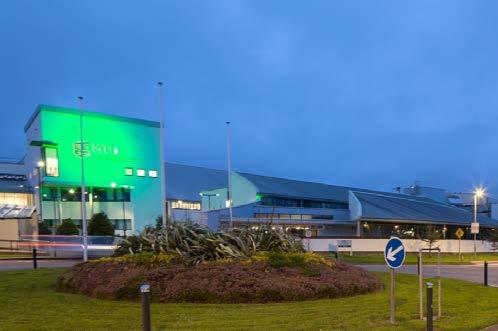
Thorn Lighting's exterior luminaires reduce Munster Technological University Kerry's (MTUK) external energy consumption and costs by over 50%, creating a warmer and more inviting ambience on campus
After the successful interior and emergency lighting upgrade as part of their Building and Estates Energy Projects, Munster Technological University Kerry's (MTUK) sought to upgrade their existing street and building surround lighting. The university's Green Campus Mission prioritises environmental considerations, aiming to identify, advance, and promote its Green Agenda with the ultimate goal of minimising its environmental impact.
The objective of the exterior lighting upgrade was twofold: to decrease energy consumption and carbon footprint while enhancing lighting aesthetics, utilising a 3000K colour temperature for car park lighting and 4000K against the buildings.
A creative combination of functional and decorative light
A balanced blend of functional and decorative lighting elements was employed. The Dark Sky-approved 3000K Isaro Pro state-of-the-art streetlights in the car parks deliver exceptional efficiency and minimise the impact of artificial light on the environment, aligning precisely with MTUK's project objectives.
Incorporating decorative D-CO LED luminaires such as Piazza, Eyekon, Katona, and Leo, meticulously
designed for energy efficiency, has allowed the university to make significant strides toward reducing its environmental footprint while adding visual interest and safety enhancements to the buildings.
Colour for impact
Strategic lighting temperature selections have optimised visibility and ambience campus-wide. By combining 3000K for car park lighting and 4000K for building surrounds, MTUK has cultivated a warm, inviting atmosphere conducive to fostering a sense of community and engagement among students, staff, and local visitors.
Thorn Lighting's LED luminaires have delivered remarkable results, halving annual external energy consumption from 105,308 kWh to 53,106 kWh and reducing CO2 emissions from 35,561 kg to 17,163 kg. This achievement underscores MTUK's dedication to sustainability and highlights the tangible benefits of investing in energy-efficient solutions.
With a payback period of less than 4.5 years and enduring benefits, MTUK's investment in Thorn Lighting's solutions illuminates the path to a brighter, greener future.
For more information on Thorn Lightings Outdoor range please visit https://www.thornlighting.co.uk/en-gb/ products/outdoor-lighting.
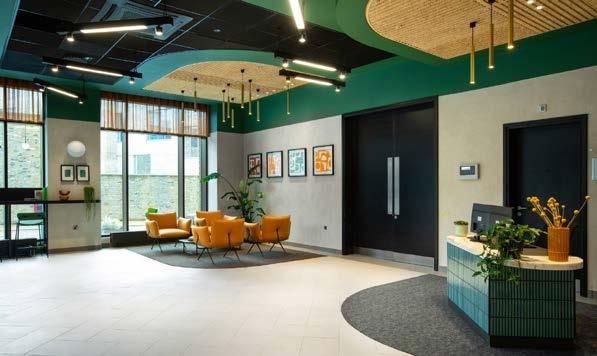
Study Group takes
Study Group has signed a deal with Sugar House Island to operate a new University of Huddersfield – London campus taking 10,604 sq ft at Chimney Walk on the Island in Stratford.
In partnership with the University of Huddersfield, Study Group will take the space to create a new satellite campus for postgraduate international students. The university will offer courses across fields including management, international business, computing and marketing.
The campus will take space at Chimney Walk, the Island’s latest and largest phase of commercial development. The CAT A offices front onto Stratford High Street, with ground floor units set to be occupied by a mix of cafes, restaurants, shops and services.
Two of the three buildings were granted dual use status earlier this year. This allows both education and office tenants to occupy the building, responding to the growing demand for education space in east London.
The University of Huddersfield - London will join the already thriving education community on the Island, with the likes of East London Dance and UD Music, who offer creative courses to aspiring artists, School 360, a primary school focusing on holistic education, and the Institute for Arts in Therapy and Education, a leading provider for courses in arts psychotherapy child counselling.
University of Huddersfield - London is the latest in a swathe of educational providers to open in the area,
following the arrival of London College of Fashion (LCF) and UCL East at East Bank and regional universities like Loughborough University and Staffordshire University at Here East.
Michael Cronin, head of portfolio at Vastint UK, said, “At Sugar House Island we are a significant way into the 26-acre masterplan with a vision to transform this once industrial site into a vibrant community and thriving hub for learning, creativity, enterprise and innovation. Acquiring dual-use status on key buildings in Chimney Walk has future-proofed our development, creating a flexible environment where education and business can converge. With its unrivalled access to talent, its excellent transport links and its proximity to all the leisure, entertainment and green space that Stratford has to offer, Sugar House Island as a truly unique opportunity for businesses and organisations alike.”
July Behl, Chief Partnerships Officer at Study Group, said, “We are delighted to be partnering with the University of Huddersfield to establish a London location for them. It was essential to find a location with impeccable international connections and an exciting offer and amenities for students. The purpose of our new business-focused campus at Sugar House Island is to put employability for our postgraduate students first, so, most importantly, the Island’s proximity to the capital’s financial district was imperative for us.”
For further information visit studygroup.com.

Turnitin Originality rises above similarity checking, addresses new and emerging trends in misconduct, and keeps integrity at the core of all student work.

The University of Wales Trinity Saint David (UWTSD) is investing in machine learning technology to support its ambitious plans to be a leading university for energy sustainability.
UWTSD, which has campuses in Swansea, Carmarthen, Lampeter, Cardiff, London and Birmingham, is already reaping the benefits of a solar power strategy – now it’s turning to artificial intelligence (AI) to transform energy efficiency across its entire estate.
The University is using AMR DNA,
an Energy Assets service, to apply AIinformed machine learning analytics to drive out energy waste, optimise efficiency, reduce consumption, and make significant steps toward net zero carbon emissions. The AMR DNA software, powered by kWIQly, progressively learns what best energy performance looks like in each building, and automatically flags up in near real-time unusual spikes in energy usage, which can be quickly addressed by the University.
“Our vision is to build on our existing position as a leading UK university for energy sustainability,”
says Dan Priddy, Finance and Business Performance Manager at UWTSD. “We’re taking real actions that will reduce Scope 1 (direct) and Scope 2 (indirect) greenhouse gas emissions by 95% by 2030.
“This will be made possible by infrastructure upgrades, more investment in renewable energy, the adoption of Net Zero construction standards on new buildings and, critically, by applying machine learning technologies,” says Dan.
“We’re already seeing the benefits of this approach. Thanks to the installation of solar panels, the
electricity demand at the Dynevor building, home to UWTSD’s Swansea Art College, is significantly met by renewables generation. Now, with the move to machine learning, we aim to ensure that our entire estate is optimised for energy efficiency and emissions reduction.”
Identifying the fingerprints of consumption
Working with the University, AMR DNA analysed years’ worth of historical meter data to identify the unique ‘fingerprints’ of consumption that would provide an energy benchmark for each of the UWTSD buildings. The software models what ‘normal’ consumption looks like, taking account of multiple factors, such as occupancy levels and operating hours, and ‘learns’ what optimal performance should look like.
Using pattern recognition linked to key performance indicators, the system interrogates metered data to spot tell-tale signs of energy waste. This waste can result from something as simple as equipment running needlessly or lights being left on overnight, or might be linked to incorrect heating timeclock controls, over-compensation for ambient weather conditions, or high summer base loads.
“We operate six campuses covering everything from student accommodation, libraries, teaching spaces and offices to engineering
workshops, manufacturing units and sports facilities,” says Dan. “This creates an estate with a lot of nuances, which makes the manual tracking of energy consumption very difficult and time consuming.
“But with machine learning, we not only see the big trends, but we also pick up on smaller issues that we would never have identified in the grand scheme of things… but they all add up. The amount of manual resource you would need to capture this level of detail would be ridiculous, but now we can, using AI.”
UWTSD started using the system in the latter part of 2023 and has already seen some significant benefits. For example, when heating had been inadvertently left on in an unattended building, the machine learning system flagged this, and it was fixed almost immediately.
“Of course, some spikes are easily explained, for example if a 3D printer is working overnight,” says Dan, “but where there is nothing obvious, we see the AMR DNA alert and ask the site teams to investigate. It means we have a clearer picture of energy consumption across the entire estate, with a greater ability not only to spot consumption spikes more easily but also to address them quickly.”
AMR DNA currently tracks performance across gas services but is about to be trialled at UWTSD to monitor efficiency in electricity networks, using data collected from
fiscal meters and sub-metered areas.
Engaging the student population
UWTSD sets its energy efficiency programme in a wider sustainability context and is active in engaging with its student population, running induction programmes for new students and staff and holding an annual Sustainability Week. Single use plastic has been banned from food outlets, disposable coffee cups are being phased out, and the University has achieved Green Flag status for its maintenance of the Carmarthen and Lampeter campuses ecosystems.
Joint action with the Students’ Union has resulted in significant progress in waste reduction and recycling rates, along with improvements to the local ecosystem by cultivating wildflower meadows.
Recent *research shows that sustainability is one of the top reasons for students selecting an educational institution.
At UWTSD, students on environmental and sustainability courses are engaged in practical projects using the University estate. This includes using energy data from the University in real life case studies.
The University has recently established an Energy Efficiency Group dedicated to spearheading efforts towards consumption reduction within campuses. This


aims to serve as a focal point for coordinating, implementing, and monitoring various energy-saving initiatives, to build accountability, ownership and to drive associated behavioural change across staff and students.
Significant infrastructure upgrades are also underway, notably via Salix loan support for renewables, in smart metering, electric heating, double and triple glazed replacement windows and LED lighting. In the next 12 months, UWTSD expects to generate a total of 700,000 kilowatt hours of onsite solar power – satisfying about 12% of its total anticipated electricity demand. The University’s remaining electricity needs are all sourced from zero carbon providers.
*Students Organising for Sustainability (SOS) ‘SUSTAINABILITY SKILLS SURVEY 2022-23’
TEC Partnership with AMR DNA UWTSD is benefiting from a framework agreement across the higher education sector between AMR DNA and The
Energy Consortium (TEC). TEC is a Contracting Authority owned by its members which delivers a wide range of services in energy procurement, data reporting, risk management and cost reduction on a not-for-profit basis.
In 2023 alone, this partnership identified and stopped 101 significant energy waste events on university campuses with a notional value of £345,000. In addition, 14 new non-waste KPIs, tracking measures such as high summer base loads, poor timeclock control and overcompensation for weather variation, were incorporated by AMR DNA into BMS strategies, resulting in a further £325,000 of waste addressed.
As a result, campuses adopting this AI-informed machine learning approach have seen a 30% decline in the average duration of major energy waste incidents and a 60% reduction in total energy waste per month over the last two years.
Says George Catto, Client Services Director for AMR DNA: “Our
experience is that energy waste can often be hiding in plain sight because it would take an army of analysts to pore over thousands of bits of historical data to spot anomalies. Machine learning can do this heavy lifting of data analysis, enabling organisations such as UWTSD to adopt a forensic approach to improving energy efficiency and reducing carbon emissions.”
Energy Assets is one of Britain’s leading independent metering, data, asset management and utility network construction companies. The Group offers utility suppliers, third party intermediaries, developers, contractors, and industrial and commercial end-users a broad spectrum of multi-utility metering and energy-related services. This includes enabling customers to collect and analyse energy consumption data.
For further information please visit www.energyassets.co.uk/service/ amr-dna.
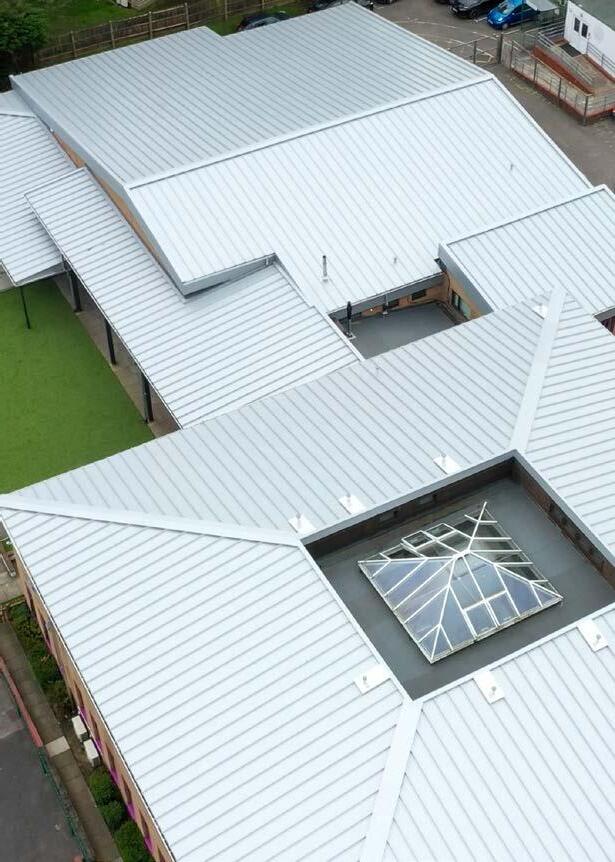
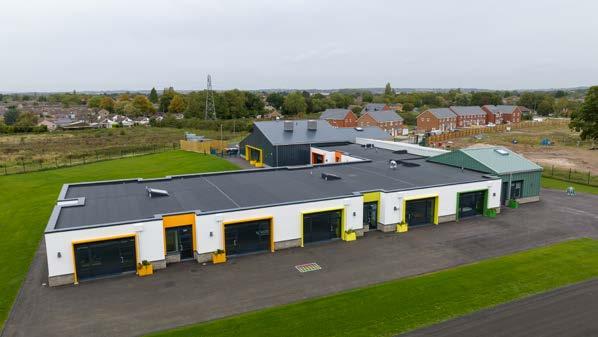
With a population growth exceeding 5% over the past decade, Derby faces increased pressure on its educational infrastructure. To address this, Derby City Council has committed £30 million to expand school capacity, including the newly constructed Oak Grange Primary School at Boulton Moor. This state-ofthe-art facility provides 354 primary school places, to meet the needs of a rapidly growing residential area.
A collaborative effort between Langley, Advanced Roofing, and main contractor Morgan Sindall Construction & Infrastructure, the project underscores the value of integrating durable and efficient roofing systems within public sector developments.
The Need for Resilient Infrastructure
Derby City Council required a roofing solution that balanced longevity, sustainability, and compliance with stringent building standards. Langley’s TA-20 flat roof waterproofing system emerged as the ideal choice, offering a 20-year Insurance Backed Guarantee (IBG) covering design, product, and workmanship.
The project serves as a benchmark in achieving energy efficiency and safety, with a U-Value of 0.15 W/ m²K, surpassing the energy efficiency standards set by Part L of the Building Regulations. Langley’s TA-20 roofing system’s BRoof(t4) certification assured compliance with Part B fire safety regulations, solidifying the project’s alignment with technical and regulatory
requirements. Together, these features highlight how innovation and compliance can work hand in hand to create exceptional new-build educational environments.
Langley’s TA-20 system was specifically chosen to meet Derby City Council’s requirements for a reinforced bituminous membrane (RBM) system that delivered reliable waterproofing and thermal efficiency.
The TA-20 system offers several key advantages that made it an ideal choice for the project. Its cost-effectiveness ensures long-term durability at a practical price point, helping the council minimize operational costs. Additionally, the system's high thermal efficiency significantly reduces heating and

cooling expenses, promoting both environmental and economic sustainability. The straightforward installation process further contributed to the project's success, enabling the roofing work to be completed smoothly within the two-month timeline.
Langley’s technical team supported Advanced Roofing with weekly site visits to ensure adherence to compliance standards, including BS6229 and NHBC
Standards. The result is a roof optimised for durability and sustainability, tailored to the needs of a growing educational hub.
The partnership between Langley and Advanced Roofing ensured smooth project execution despite the tight schedule. By maintaining close collaboration and leveraging Langley’s extensive technical expertise, the team completed the
roof installation on time, meeting both safety and quality requirements.
The ease of use of the TA-20 system allowed Advanced Roofing to execute the project without the need for major design customisations, ensuring rapid installation without compromising quality. This straightforward approach proved essential for the school’s timely opening and long-term operational efficiency.

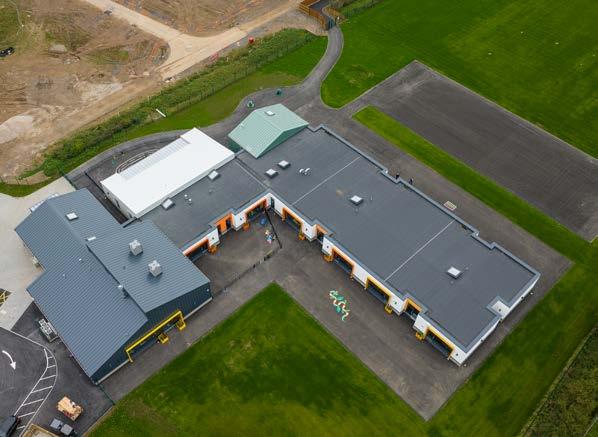
By integrating Langley’s TA-20 roofing system, Oak Grange Primary School achieves significant sustainability gains, aligning with Derby City Council’s environmental goals. The system’s high-performance insulation reduces energy consumption, supporting the council’s commitment to minimising emissions across public estates.
The successful collaboration between Derby City Council, Langley, Advanced Roofing, and Morgan Sindall highlights the importance of reliable partnerships in public sector projects. Oak Grange Primary School now stands as a benchmark for sustainable, high-quality educational facilities, ensuring comfort and efficiency for generations to come.
Dean Jetson, supply chain manager at Morgan Sindall said: “Delivering Oak Grange Primary School was an exciting challenge that allowed us to showcase
our commitment to quality and innovation. Partnering with Langley and Advanced Roofing enabled us to not only meet the project requirements but also exceed the expectations of Derby City Council in terms of sustainability and operational efficiency.”
Connor Wignall, senior estimator at Advanced Roofing, said: "Our collaboration on Oak Grange Primary School shows the critical role roofing systems play in creating sustainable and efficient educational environments. Working with Langley’s TA-20 system meant that we were able to deliver a solution that meets Derby City Council’s rigorous specifications and provides long-term durability and energy efficiency. It’s rewarding to see how this project will contribute to Derby’s growing educational infrastructure while supporting environmental goals.”
Simon Griffiths, new build national sales manager from Langley said: “This project presented
an opportunity to showcase the adaptability of our TA-20 system in a new-build school setting. Collaborating with Advanced Roofing allowed us to tailor a solution that addresses both the immediate and long-term needs of Derby City Council.”
As Derby City Council continues to expand its educational infrastructure, Langley’s TA-20 system stands as a benchmark in delivering cost-effective, high-quality roofing solutions that support sustainability and community development goals. This project underscores Langley’s commitment to combining technical expertise with responsive collaboration, providing solutions that are resilient, compliant, and designed for the long-term benefit of public facilities.
For more on Langley’s roofing solutions and services, please visit Langley.co.uk
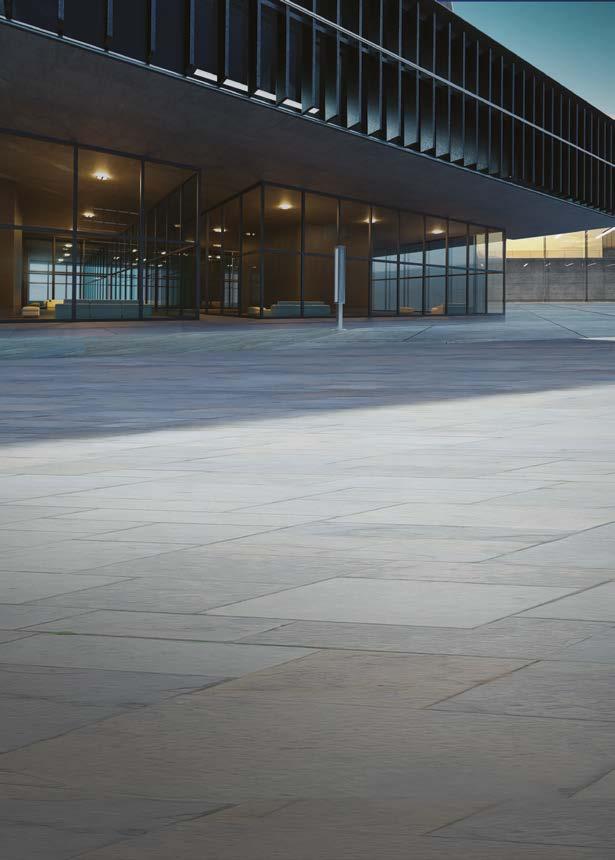


First impressions count, especially for institutions that require specialist site management, such as schools/colleges, that have a very short space of time to make an impression. Nothing quite detracts from the look of an institution like dirty windows; the lack of care on the outside can send a clear signal to visitors that the insides see the same level of care, when in reality, this is unlikely to be the truth.
Thankfully, recent years have seen huge technological advances in window cleaning technology, and there’s a vast range of new tech that can help keep windows clean without the effort. From autonomous robot cleaners to drones and
nanotechnology, there’s plenty of new technology on the market. Here, The Heritage Window Company take a look at some of the most futuristic window cleaning technology you can buy to level up your facility, school, factory or campus windows in 2024.
Key findings
• Pure water filtration systems purify standard tap water into pure H20, which makes cleaning far easier without the use of cleaning compounds.
• Remote-controlled window cleaning drones are making it easier to tackle hard-to-reach exterior windows.
• Interior window cleaning robots
can detect dirt on your windows and take the most energy-efficient path to rid your windows of dirt.
• Nanotech cleaners use nanoparticles to create a protective film on your windows once they’ve been cleaned, reducing the need for future cleaning.
Want to get cleaner windows, reduce your use of cleaning compounds and use less water in the process? You should be using pure water for your windows! Many modern window cleaners are using pure water cleaning systems, which filter standard tap water into pure H20, leaving your windows looking cleaner
than ever.
The outcome? You can enjoy cleaner windows without using cleaning compounds, limiting your impact on the planet.
Exterior window cleaning drones
Sounds like something out of a sci-fi novel, right? Well, window cleaning drones are here, and they’re already making life a breeze for their owners. Hard-to-reach windows are a thing of the past, as these remote-controlled cleaners can be safely operated without even going outside!
Window-cleaning drones are already being used for high-rise offices and awkwardly shaped buildings where human intervention might be dangerous. Completing projects at a fraction of the time and cost of human counterparts, window cleaning drones are poised to play a big part in the future of commercial window cleaning.
Interior window cleaning robots
Drones might be able to tackle the
outside of windows with ease, but if you’re looking for a schedule-andforget solution to cleaning workspace windows from the inside, you might need a personal robot. Think of this technology like a Roomba for a window – these robots attach themselves to the inside of the window with super-strong suction and are programmed to take the most efficient path for maximum cleanliness.
Magnetic window cleaning
Looking to cut down the time spent cleaning windows or forego paying professionals to clean them for you? One of the cheaper – but just as practical – developments in window-cleaning tech is the rise of the magnetic window cleaner. Just pop one half of the magnetic cleaner on the outside of the window and the other half on the inside, and you’ll be able to clean both sides without having to venture outside at all.
The magnetic window cleaners of yesteryear fell firmly into the
“gimmicky” category, tending to fail when confronted by modern double glazing. However, with stronger magnets and better-quality cleaning pads, you can rely on today’s versions to leave your windows with a great finish. This is especially useful for tall office blocks which would typically require specialist equipment to reach windows on higher floors.
cleaners
The use of nanotechnology is a great way to reduce the frequency with which you have to clean your windows. These types of cleaners utilise nanoparticles, which not only dissolve the dirt on your windows, but also “heal” the glass after cleaning it, forming a protective coating which negates the need for more regular cleaning. With this coating, you can expect up to 80% less dirt, oil or dust to attach itself to the window going forward, making future cleaning easier.

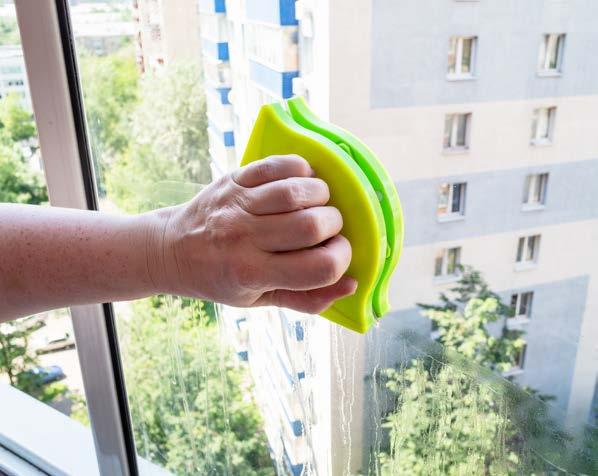
Pressure washing
Sick and tired of dealing with tough dirt in the corners of your windows? You might be hesitant to apply a power washer to your window, but the control and flexibility provided by newer pressure washers means that you can tackle tough dirt that’s been baked hard by exposure to the hot sun.
Pressure washing is particularly suited to newer, more robust window frames such as aluminium windows or vinyl windows. “Try and avoid pressure washing older wooden window frames,” comments Kevin Brown, Managing Director at The Heritage Window Company – “the power of the pressure washer could warp your window frames and irreparably damage seals and paintwork.”
The window cleaning of the future Since today’s window cleaning
technology probably sounds incredibly far-fetched to those living even 100 years ago, we asked AI chatbot ChatGPT to imagine what window cleaning technology might look like in the future. Here are some highlights:
Self-cleaning glass: “Windows themselves might be made of smart materials that can repel dirt and contaminants. These self-cleaning windows could use technologies like electrochromism or responsive coatings to actively resist staining, reducing the need for external cleaning.”
Augmented Reality (AR) Systems: “AR could be integrated into window cleaning systems, allowing technicians to visualise dirt and contaminants through smart glasses. AR overlays could guide cleaning devices precisely to affected areas,
optimising the cleaning process.”
Solar-Powered Cleaning:
“Windows could harness solar energy to power embedded cleaning mechanisms. Photovoltaic cells on the glass surface could generate electricity to drive cleaning processes, making the technology more sustainable and self-sufficient.”
Brown comments: “The window cleaning sector has made some great technological strides in recent years, and is showing no signs of slowing down! It’s been great to see how modern advancements have been helping make life easier for homeowners, institutions, businesses and window cleaners alike.
I’m not sure whether augmented reality would make window cleaning any easier! But if it’s helping us optimise the cleaning process, I’m all for it!”



Discover exceptional campus-wide WiFi and mobile signal coverage with Simpli-Fi's enterprise wireless connectivity solutions.

Working on a better future with schools, colleges and universities throughout the UK.

Enterprise WiFi - Next-generation speeds and security.
In-Building Mobile Signal Coverage – No more dropped calls.
Wireless Point-to-Point – Wirelessly link your campus buildings.



Key points for good water management; written by Daniel Pitcher, Managing Director , Water Hygiene Centre
Good water safety management within school properties can be distilled into the following areas:
• Determining management arrangements and responsibility;
• Establishing the level of Legionella risk and devising an action plan
proportionate to risk;
• Evidencing how Legionella risk has been suitably controlled, managed and reviewed.
Legionella Guidance
ACoP L8 and HSG 274 Part 2 provide the most current guidance and practical advice on managing the
Legionella risk– ultimately to help ensure compliance with various health and safety regulations i.e. COSHH and the Management of Health and Safety at Work Regulations (MHSWR).
Establishing the level of risk within school properties can be further compartmentalised into two
main areas:
• Governance Arrangements i.e., Management Policy;
• Operational Arrangements i.e., Water Safety Plan / Written Scheme of Control
Whilst many of the governance and operational water safety responsibilities may be delegated to an appointed Responsible Person (RP), it is noteworthy that the Duty Holder will retain overall accountability for health & safety risks within the school.
It may be prudent to consider this when planning the resources and budget required to ensure that all health and safety concerns are adequately addressed. The threat from Legionnaires’ Disease is considered ‘preventable’ and when contracted from an estate, invariably there will be legal ramifications…
Starting with ‘Governance’; it’s important to identify and establish a hierarchy of authority (known as the ‘Communications pathway’) for water safety management ensuring that those responsible are demonstrably competent to undertake their role. Doing so will help the school to suitably delineate between management and operational water safety responsibilities.
The responsibility to manage and deliver the ‘Operational Arrangements’ of a Water Safety Plan / Written Scheme of Control
typically falls within the role of the RP. Nominating a demonstrably competent person (known as the RP) is a requirement of ACoP L8 and HSG 274 Part 2 and is a role of significant responsibility.
The RP is the ‘directing mind’ of the school - often the Principal / Head Teacher (depending on the type of school). The RP may not necessarily possess all technical knowledge on water safety and may be lacking in water safety experience, therefore operational authority may be delegated to a Deputy RP / Authorised Person.
The Deputy RP / Authorised Person will then ensure the estate is managed following the operational Water Safety Plan / Written Scheme of Control and provide assurances to the RP through monitoring records on the state of compliance.
Once the management structure has been agreed upon and formalised within a policy document, water safety management considerations now become more ‘operational’. For example, a good starting point for a school, as for any organisation, would be to commission a sitespecific Legionella risk assessment with accompanying schematics.
Carrying out a site-specific Legionella risk assessment is an absolute requirement under health and safety law. Provided that the risk assessment is accurate and ideally completed following the relevant
standards, such as BS8580-1:2019 Water Quality. Risk Assessment for Legionella Control and/or by a UKAS accredited organisation, then the full extent of the Legionella risk will be captured.
The risk assessment should include a survey that includes all the systems that may contribute to or cause a risk of waterborne infection. Risks should be evaluated and quantified based on the likelihood of Legionella contamination within a given system and the consequence of infection from these bacteria, using a scoring system for example.
Once the risk assessments have been completed, an assessment of perceived inherent and actual risk will be provided by the risk assessor. In practice, this often generates recommendations on how Legionella risk can be reduced within the school. The risk assessment can therefore be used to inform the Water Safety Plan / Written Scheme of Control and assist with the development of an action plan that identifies the corrective action to be taken as well as realistic timescales for completion.
Schools, as with all organisations, must at this stage identify what is reasonable and practicable to include within the action plan to help ensure that the water safety management approach remains sustainable for the organisation.
School water systems that could


present a risk and will more than likely include, but not necessarily be limited to, the following types of risk systems:
• Domestic cold-water systems –cold water (i.e. less than 20°C) is to be achieved at the outlet within two minutes. This should be confirmed by monthly monitoring from sentinel outlets (i.e. those nearest and farthest from the water source);
• Cold water storage tanks (stored cold water) – ensure that temperature within the tank is less than 20°C, the take is adequately sealed to prevent the ingress of organic contamination;
• Domestic hot-water systems – hot water should be heated to at least 60°C and be distributed to all parts of the system at 50°C or above. Hot water should achieve temperature within 1 minute of opening the sentinel outlet (non-circulating systems). With circulating hot water systems this should be confirmed by taking the temperature from the pipework of the various return loops (principal, subordinate, tertiary) where the temperature should be achieving 50°C or above;
• Hot water generators (stored hot water) – stored hot water should be no less than 60°C and therefore flow at no less than 60°C from the generator with a return
temperature back to the generator achieving at least 50°C. Point of use water heaters to operate at 50–60 °C or to achieve a high turnover
• Showers – ensure that these outlets are cleaned and descaled or replaced at least quarterly. If showers are infrequently used, they should be removed or flushed regularly at least weekly. Flushing activities are to be captured in a documented programme with records kept as evidence;
• Wash hand basin tap outlets –ensure that all outlets are used or flushed at least once weekly. Similarly, if there are infrequently used outlets then they should be removed or captured in the aforementioned Legionella flushing regime;
• Cold water storage tanks (stored cold water) – ensure that temperature within the tank is less than 20°C, the tank is adequately sealed to prevent the ingress of organic contamination;
• Hot water generators (stored hot water) – stored hot water should be no less than 60°C and therefore flow at no less than 60°C from the generator with a return temperature back to the generator achieving at least 50°C;
• Thermostatic mixing valves (TMVs) – the installation of TMVs should be informed by a scalding
risk assessment! Depending on the asset which the TMV is serving, the water temperature should be regulated to 41°C +/- 2°C to mitigate scald risk. However, this falls within a temperature range that encourages the growth of waterborne bacteria (20-45°C) and therefore these risk systems should be dismantled, cleaned, disinfected and functional checks at least annually.
Conclusion
The HSE’s HSG274 Technical Guidance, Part 2, Table 2.1 provides practical guidance on the minimum requirements for the management of water risk systems. Therefore, whilst it’s not mandatory to follow the guidance, bear in mind that should the guidance not be followed then an organisation will need to demonstrate that they have achieved either an equivalent or better standard.
Finally, comprehensive and complete water safety records must be kept and be easily accessible, i.e in a log book system. A failure to provide sufficient evidence to demonstrate that the risk of Legionella is being managed and that systems are in control could be interpreted as a failure to ensure that the water is safe.



Construction work has completed on the brand-new sports hall at Minsthorpe Community College in South Elmsall and is now open to students at the start of their new term
The project, carried out by lead contractor Henry Boot Construction, part of Henry Boot, has provided a brand-new facility which includes a 6,394 sq ft main sports hall, two activity studios, changing rooms, toilets, storage facilities and office space.
Work began in summer 2023 to replace the previous sports facilities alongside refurbishment works to several of the existing blocks within the college. The remaining
works, including the installation of a multi-use games area (MUGA), will be completed in spring 2025.
Social value and sustainability have been front-and-centre of the project for Henry Boot Construction.
“The construction of a new sports hall will bring transformative benefits to both the college and the wider community,” commented Jack Kidder, Responsible Business Manager at Henry Boot.
“Beyond enhancing the College’s facilities, it will provide a vibrant hub for physical activity, fostering health, well-being, and teamwork among students. For the local community, the sports hall also offers opportunities for engagement through events and recreational
use – creating a shared space that strengthens community ties.”
“As a contractor, we’re proud to contribute to a project that not only boosts the College’s infrastructure but also leaves a lasting legacy of social value by promoting inclusivity, active lifestyles, and a stronger, more connected community.”
Throughout the development, the project team had a close working relationship with the College’s students, leadership team and the Department for Education to ensure the project met educational needs while engaging and empowering the students.
The Student Construction Council Partnership (SCCP) was a Minsthorpe student-led body at the heart of the
project that guided its social value strategy.
Involved throughout the project, the SCCP created designs for the hoardings, provided vital feedback on the appearance of the new internal spaces and became a communication link between the construction team and the staff and students within the College.
The Minsthorpe students have also taken part in multiple workshops, careers information sessions, site visits and work experience, offering them an insight into the world of construction and potential future career opportunities.
Chris Weathers, Commercial Director at Henry Boot Construction, said:
“This has been a wonderful project for Henry Boot Construction to be a part of over the last 18 months.
“Since the beginning of the design and planning process, the project team had a clear vision of what the final product will look like, and now that work on the sports hall is finished, it’s a credit to the team to see it matching the ambitions set out before work began.
“Projects like this are always extremely fulfilling, providing

high-quality facilities to the local community that will greatly benefit them. We have modernised existing spaces so that curriculum activity can be fully supported, greatly enhancing the student experience.
“It’s also a fantastic blueprint for education-sector projects moving forward – demonstrating the importance of engaging pupils in the design and build of their new spaces.”
Joint Principals Mark Gilmore and Rachael Merritt, from Minsthorpe
Community College, said:
“We’re delighted to be chosen as one of the first 50 schools to be part of the Department for Education’s School Rebuilding Programme.
“The new sports complex and the refurbishment works to several of the existing blocks is the final piece in the jigsaw in bringing the College’s facilities into the 21st century meaning the experiences of both our amazing students and fantastic community will be enriched for years to come.

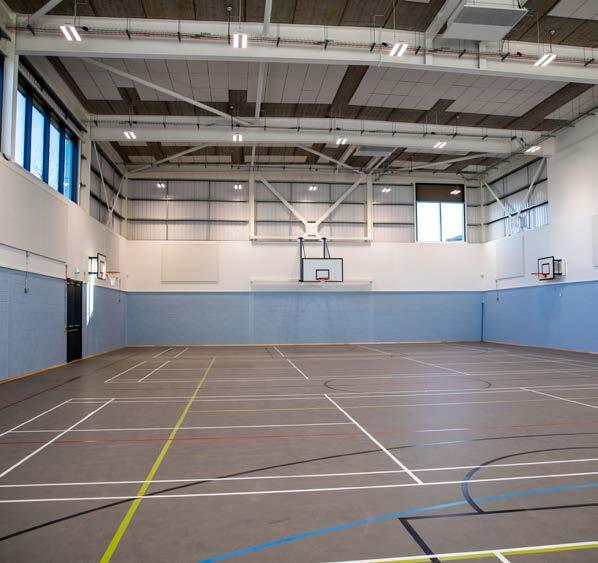
“The opportunity the SPPC has gained from their collaborative work with The Responsible Business Manager, and the construction team on site has added a really valuable layer of careers education to our students’ experience. It has provided excellent encounters with employers and employees, experiences of workplaces, and being able to link their learning through the curriculum with actual jobs which has contributed positively to the College meeting all the Gatsby Benchmarks.”
Henry Boot Construction has completed several significant projects in the region over recent years, including a two-storey
Alan Macklin
extension at Allerton High School and refurbishment of Headingley Learning Centre in Leeds, and major residential development, The Cocoa Works – the stunning refurbishment of the iconic former Rowntree Factory in York.
Henry Boot Construction is part of Henry Boot, one of the UK’s leading land, property development, home building and construction businesses. Together, we are where great places start.
Henry Boot Construction is an award-winning contractor that’s committed to the highest possible standards. Known for building with integrity, authenticity and passion, we
offer a full range of pre-construction and construction services in the industrial and logistics, residential and urban development sectors.
We have extensive experience in both the public and private sectors, including major projects such as the residential restoration of The Cocoa Works in York, the University of Sheffield AMRC’s aviation research and development facility and key schemes within Sheffield’s Heart of the City development.
For further information please visit www.henrybootconstruction.co.uk.

• Constructor (modular building supply) and main contractor (as required) that offers a full turnkey solution approach.
• Architecturally designed & inspirational learning environments. Our buildings can be visually indistinguishable from traditionally built schools.
• Utilising SEISMIC platform design and achieving a high level of PMV.
• Customised to client specifications and needs. From glazing to wall cladding finishes; even teaching spaces can be configured.
• Repeatable classroom designs, creating efficiency through standardisation. Standardisation is key to driving greater efficiency throughout all aspects of the project and delivery.
• We are recognised by a number of key frameworks, which are the DfE MMC1 LOT 1, CCS, NHS-SBS and the LHC.


BAM Construct UK has collaborated with Altro and Recofloor to achieve significant sustainability gains on a number of major school construction projects
At Weldon Village Academy, a new purpose-built secondary school near Corby, BAM Construct UK built the state-of-the-art, three-storey facility to provide education, sport and recreation facilities for the community as well as the school population. At the start of the project, Dave Ellis, Regional Director – Midlands for BAM Construct UK said: “Sustainability will be central
to our approach as we look to create a school that features eco-efficient features.”
To ensure an overarching sustainable building, the interior materials were selected for, among other criteria, their reduced embodied carbon properties. This included the flooring throughout, which needed to provide recyclability and high slip-resistance for busy areas, such as corridors and classrooms. BAM Construct UK approached Altro, their supply chain partner, for support and guidance with specifying the correct floors.
Adhesive-free safety floor Altro XpressLay was specified for the corridors and classrooms, providing speed of installation and ease of maintenance ensuring the busy areas were returned to use quickly and completed to project timescales. Altro XpressLay is installed without adhesive or DPM, providing easy access to subfloors, and avoiding any unpleasant adhesive odours.
Like all Altro adhesive-free floors, it utilises a unique formulation for a quick fit without compromising on performance or durability. The revolutionary technology, featuring
a studded surface on the underside of the floor, allows it to lie flat and perform like a traditionally adhered floor without the need for an adhesive. Floors can be installed and walked on the same day.
Altro XpressLay utilises a unique formulation for a quick fit without compromising on performance or durability. Our revolutionary technology, featuring a studded surface on the underside of the floor, allows it to lie flat and perform like a traditionally adhered floor without the need for an adhesive. Floors can be installed and walked on the same day. Co-ordinates with Altro Walkway™ 20.
Recofloor, the UK’s first waste vinyl floor take back scheme, was introduced into the build, providing collection of clean vinyl offcuts for recycling. “Shared objectives from the outset contributed to a successful

and sustainable outcome” explains Carla Eslava, Recofloor Scheme Manager. “Every offcut matters when it comes to diverting waste vinyl from landfill.” The vinyl offcuts
collected from the 3,000 sqm of Altro XpressLay installed at Weldon Village Academy avoided 1.88 tonnes of embodied carbon emissions.
Sustainability was also high on the
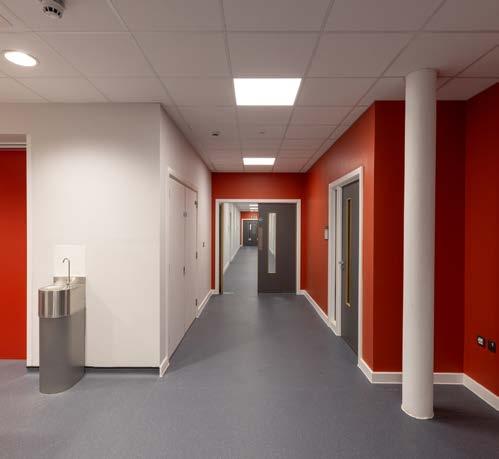

agenda for the new school extension at Holyrood Academy, Somerset. The architect initially specified traditional adhered flooring, but main contractor BAM saw the opportunity for time and cost savings as well as huge sustainability benefits by switching the specification to adhesive-free options.
Representatives from BAM Construct UK, Altro and Recofloor met to discuss options for specification, and managing and recycling waste from the build. After the consultation, and with prior knowledge and experience of previous successful installations, adhesive-free floors options were reviewed and selected based on the cost and time benefits, plus embodied carbon avoided.
“It was imperative we delivered the build to timescales, but as sustainably as possible. The adhesive- free floors saved project time and reduced carbon output.”
said Graham Holt, Construction Project Manager, BAM Construct UK.
At Holyrood Academy, Altro Wood adhesive-free safety floor was specified for the dining area and Altro Cantata adhesive-free was specified for the corridors and communal areas, providing a safe, durable and decorative solution for the busy spaces.
David Lever, Altro’s Sustainability Manager, says: “There are many cost and time advantages to using Altro adhesive-free flooring, which requires no adhesive and no damp-proof membrane, but the saving in embodied carbon achieved by avoiding these elements is the real headline grabber. Figures produced by the team on the Holyrood Academy project showed that switching the specification from adhered to adhesive-free gave an approximate carbon-saving of 59%, preventing 3.89 tonnes of embodied carbon emissions.”
There are also plenty of benefits when it comes to installing Altro adhesive-free floors, as John Redford from RBJ Flooring, the installer at Holyrood Academy, explains: “It went really smoothly, in large part due to the planning and professionalism of the main contractor and the products selected for use. The site was prepared and ready for when we arrived, and our team enjoy working with the Altro products, particularly adhesive-free, which we have a lot of experience with. Using these takes out the wet trades, means we don’t have to lump around 100s of bags of screed, mix it, clean everything down and so on. We’re very happy laying these products.”
Find out more about the many benefits of adhesive-free floors here: www.altro.com/uk/learn-andengage/altro-guides/adhesive-freefloors






As Europe’s leading supplier, installer and integrator of digital television and audio visual equipment, Airwave can deliver your vision. With a presence in all key sectors including: healthcare, education, retail & leisure, stadia, prisons and transport, Airwave’s customer base is diverse.
www.airwave.tv

The ASSA ABLOY Group is the global leader in access solutions. Our offering covers products and services related to openings, such as locks, doors, gates and entrance automation solutions. This also includes expertise in controlling identities with keys, cards, tags, mobile and biometric identity verification systems.
www.assaabloy.com




Club Car boasts nearly 60 years of industry-leading innovation and design, initially focused on golf cars and then expanding to commercial utility vehicles and personal-use transportation.
www.clubcar.com





As the UK’s market-leading provider of technology led compliance and risk management solutions, our purpose is to help organisations be safer, healthier, and stronger. Our guide explains a range of measures and safety commitments so that universities are fully prepared and to keep the spread of the virus under control.
www.alcumusgroup.com
Buildings today don’t only provide a safe, functional place for people to live and work. They can also cater for – and even respond to – their needs, while helping them work more efficiently and sustainably. At Bosch Building Technologies, we are at the forefront of these new developments.
www.boschbuildingtechnologies.com
Our education solutions are developed from the ground up to increase campus security and safety while extending the capabilities of student, faculty and staff ID badges. Our solutions can be used for convenient access to buildings, computer login, cashless vending and campus activities.
www.hidglobal.com
Hysopt is unique design software that helps building managers get the most out of their heating and cooling systems. In collaboration with installation companies and engineering firms, we can cut your annual energy bill by 10 to 50%.
www.hysopt.com

LapSafe® created its first products to meet the needs of the education market and although we have since expanded into many other sectors, this remains our largest and most established area of expertise. Our products have been thoroughly tested by every type of education and academic institution
www.lapsafe.com



Originally founded in 1921, the company known today as Mitsubishi Electric has almost 100 years of experience in providing reliable, high quality products and support to installers, specifiers, corporate clients and general consumers all over the world.
https://les.mitsubishielectric.co.uk


From its inception in 2001, SALTO was created with one objective: to devise a world-class access control system that was simple to use and extremely efficient, giving users the ability to control all their access needs and secure all their doors without complex and expensive wiring.
www.saltosystems.com

As a trusted advisor and reliable partner, as a system integrator, service provider and a product vendor, Siemens offers energy-efficient, safe and secure buildings and infrastructure. With our people, our global footprint and our technical expertise, it's our passion helping you to create the perfect place – your perfect place.
www.siemens.com


Award-winning AV integrator, providing bespoke AV solutions with a strong company ethos, collegiality and partnership approach. Evolving with developments in AV technology allows Strive AV to deliver excellence across education, corporate, health and retail environments, providing AV solutions which transform communication and enhance end user’s experiences.
www.striveav.com






With more and more consideration being given to energy usage and the increasing implementation of green legislation, PumpSmart Limited is able to assist with the identification of areas where real energy savings can be made. New products, aimed at energy consumption reduction, are constantly entering the market with potential to improve existing installations.
www.pumpsmart.co.uk
We drive digital transformation by integrating world-leading process and energy technologies to realize the full efficiency and sustainability opportunities for your establishment. We provide end-point to cloud integration connecting products, controls, software and services.
https://www.se.com
Simpli-Fi are expert at helping educational establishments get the most out of wireless technology. We implement bespoke, reliable, scalable, flexible, and secure enterprise-grade, managed wireless networks that connect unlimited devices anywhere on site.
www.simpli-fi.co.uk
Veolia Water Technologies UK (VWT UK) is a leading water treatment solutions and services provider with a unique global presence and 160 years of experience. VWT UK strives to provide innovative solutions such as the new PURELAB Quest compact water purification unit that can generate Type I, II and III water.
www.veoliawatertechnologies.co.uk
Discover how to maximize efficiency, safety, and productivity with an integrated university infrastructure.

Make the most of your energy